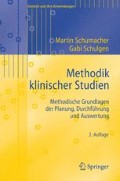Access this chapter
Tax calculation will be finalised at checkout
Purchases are for personal use only
Preview
Unable to display preview. Download preview PDF.
22.6 Literatur
Aalen OO, Johansen S. An empirical transition matrix for non-homogeneous Markov chains based on censored observations. Scandinavian Journal of Statistics 1978; 5:141–150.
Andersen PK, Abildstrom SZ, Rosthoj S. Competing risks as a multi-state model. Statistical Methods in Medical Research 2002; 11:203–215.
Andersen PK, Borgan O, Gill RD, Keiding N. Statistical models based on counting processes. New York: Springer; 1993.
Andersen PK, Keiding N. Multi-state models for event history analysis. Statistical Methods in Medical Research 2002; 2:91–115.
Colhoun HM, Betteridge DJ, Durrington PN et al.. Primary prevention of cardiovascular disease with atorvastatin in type 2 diabetes in the Collaborative Atorvastatin Diabetes Study (CARDS): multicentre randomised placbo-controlled trial. Lancet 2004; 364: 685–696.
Cox DR. Regression models and life-tables (with discussion). Journal of the Royal Statistical Society, Series B 1972; 34:187–220.
Fayers PM, Machin D. Sample size: how many patients are necessary. British Journal of Cancer 1995; 72:1–9.
Grunkemeier GL, Wu YX. Interpretation of nonfatal events after cardiac surgery; actual versus actuarial reporting. The Journal of Thoracic and Cardiovascular Surgery 2001; 122:216–219.
Kalbfleisch JD, Prentice RL. The statistical analysis of failure time data. New York: Wiley, 1980.
Kaplan EL, Meier P. Nonparametric estimation from incomplete observations. Journal of the American Statistical Association 1958; 53:457–481.
Koch M, Kutkuhn B, Grabensee B, Ritz E. Apolipoprotein A, fibrinogen, age, and history of stroke are predictors of death in dialysed diabetic patients: a prospective study in 412 subjects. Nephrology Dialysis Transplantation 1997; 12:2603–2611.
Lachin JM, Foulkes MA. Evaluation of sample size and power for analyses of survival with allowance for nonuniform patient entry, losses to follow-up, non-compliance, and stratification. Biometrics 1986; 42:507–519.
Marubini E, Valsecchi MG. Analysing survival data from clinical trialsand observational studies. Chichester: Wiley, 1994.
Montori VM, Permanyer-Miralda G, Ferreira-Gonzalez I et al.. Validity of composite end points in clinical trials. British Medical Journal 2005; 330:594–596.
Pintilie M. Dealing with competing risks: testing covariates and calculating sample size. Statistics in Medicine 2002; 21:3317–3324.
Sacks FM, Pfeffer MA, Moye LA et al.. The effect of Pravastatin on coronary events after myocardial infarction in patients with average cholesterol levels. The New England Journal of Medicine 1996; 335:1001–1009.
Scandinavian Simvastatin Survival Study Group. Randomised trial of cholesterol lowering in 4444 patients with coronary heart disease: the Scandinavian Simvastatin Survival Study (4S). The Lancet 1994; 344:1383–1389.
Schoenfeld DA. The asymptotic properties of nonparametric tests for comparing survival distributions. Biometrika 1981; 68:316–319.
Schoenfeld DA. Sample-size formula for the proportional-hazards regression model. Biometrics 1983; 39:499–503.
Schmoor C, Sauerbrei W, Schumacher M: Sample size considerations for the evaluation of prognostic factors in survival analysis. Statistics in Medicine, 2000; 19:441–452.
Schulgen G, Schmoor C, Sauerbrei W, Schumacher M. A note on estimating local recurrence rates in clinical trials on the treatment of breast cancer. Breast Cancer Research and Treatment 1998; 49: 87–91.
Schulgen G, Olschewski M, Krane V, Wanner C, Ruf G, Schumacher M. Sample sizes for clinical trials with time-to-event endpoints and competing risks. Contemporary Clinical Trials 2005; 26:386–396.
Shepherd J, Cobbe SM, Ford, I et al.. Prevention of coronary heart disease with Pravastatin in men with hypercholesterolemia. The New England Journal of Medicine 1995; 333:1302–1307.
Tschöpe W, Koch M, Thomas B, Ritz E. Serum lipids predict cardiac death in diabetic patients on maintenance hemodialysis. Results of a prospective study. Nephron 1993; 64:354–358.
Yateman NA, Skene AM. Sample sizes for proportional hazards survival studies with arbitrary patient entry and loss to follow-up distributions. Statistics in Medicine 1992; 11:1103–1113.
Wanner C, Krane V, Ruf G et al. for Die Deutsche Diabetes Dialyse Studie Investigators: Rationale and design of a trial improving outcome of type 2 diabetics on hemodialysis. Kidney International 1999; 56,Suppl 71:222–226.
Wanner C, Krane V, März W et al. for the Deutsche Diabetes-Dialyse-Studie (4D) Study Group: Randomized controlled trial on the efficacy and safety of Atorvastatin in patients with type 2 diabetes on hemodialysis (4D Study): Demographic and baseline characteristics. Kidney Blood Press R, 2004; 27:259–266.
Wanner C, Krane V, März W, Olschewski M, Mann JFE, Ruf G, Ritz E. Atorvastatin in patients with type 2 diabetes mellitus undergoing hemodialysis. New England Journal of Medicine 2005; 353:238–48.
Author information
Authors and Affiliations
Rights and permissions
Copyright information
© 2007 Springer-Verlag Berlin Heidelberg
About this chapter
Cite this chapter
Schulgen, G., Olschewski, M., Schumacher, M. (2007). Ereigniszeiten und konkurrierende Risiken — zur Planung und Auswertung der 4D — Studie. In: Methodik klinischer Studien. Statistik und ihre Anwendungen. Springer, Berlin, Heidelberg . https://doi.org/10.1007/978-3-540-36990-5_22
Download citation
DOI: https://doi.org/10.1007/978-3-540-36990-5_22
Publisher Name: Springer, Berlin, Heidelberg
Print ISBN: 978-3-540-36989-9
Online ISBN: 978-3-540-36990-5
eBook Packages: Life Science and Basic Disciplines (German Language)

